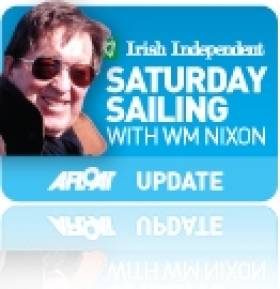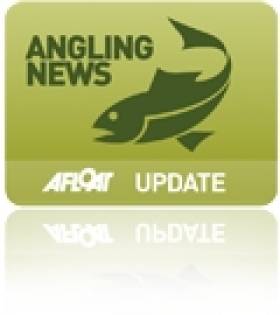Displaying items by tag: Greenland
Inland Fisheries Ireland Assists in International Salmon Research Project in Greenland
Inland Fisheries Ireland (IFI) has taken part in a tagging project for salmon that tracks their epic sea swim from Greenland to Europe.
IFI researcher Glen Wightman represented the agency in an EU-funded programme in the east Greenland settlement of Kuummiut, tagging salmon as they returned to their European rivers of origin.
Wrightman collaborated with scientists from the Technical University of Denmark (DTU) to investigate the feeding and return migratory behaviour of young Atlantic salmon as they left the Arctic Sea.
Dr William Roche, senior research officer at IFI said: “This study comprises novel research into a fish species that’s in worrying decline. It’s being conducted because the marine phase of a salmon’s life is where knowledge of its survival is limited.
“We are making use of the strong homing trait of salmon. The aim is to fill a data gap because detailed information about salmon behaviour and migration routes in the ocean is scarce.
 Panoramic view of Kuummiut settlement in south-eastern Greenland, the base location for the salmon-tagging project | Credit: Glen Wightman/IFI
Panoramic view of Kuummiut settlement in south-eastern Greenland, the base location for the salmon-tagging project | Credit: Glen Wightman/IFI
“It is hoped that the scientific information gleaned will provide further clues into the complex question of poor survival of salmon at sea.
“We are seeking more data on the return journeys these salmon undertake, and the numbers that actually make it back to the rivers where they are from.”
Sample salmon were implanted with a tracking device during this pilot phase of the study and monitored rivers in Europe will be checked for returns of these particular fish.
The new programme is focused on capturing live pre-adult salmon in their feeding areas on the east coast of Greenland.
Led by DTU’s Professor Kim Aarestrup, Dr Niels Jepsen, and IFI’s Glen Wightman, it is being carried out under the Smoltrack project, coordinated by the North Atlantic Salmon Conservation Organisation.
Hydrophones Dropped Off Greenland Recording Sounds of Melting Arctic Icebergs to Fuel Irish Artist’s ‘Ocean Memory’ Project
An Irish artist is part of an international expedition that’s dropping hydrophones into the waters off Greenland to record the sounds of melting icebergs.
According to the Guardian, Siobhán McDonald will use the recordings from the underwater microphones in a mixed-media installation to explore human impact on the world’s oceans.
Over the next two years, the hydrophones will capture the sounds of melting Arctic sea ice and under subaquatic audio every hour — with the results being used both in scientific research and as part of a musical score McDonald will create with a composer.
My floating studio on expedition in the deepest part of the Greenland ocean. Just passed the awesome Greenland glacier yesterday. #arctic #water #northernlights #painting pic.twitter.com/Mk8sxSgh9W
— Siobhan McDonald (@SioMcDonald) October 11, 2022
“I’m interested in hearing the acoustic pollution,” the artist says. “The sea levels are rising and that will have an impact I’d imagine on the sound range and on all the biodiversity.
“Sound is fundamental in the ocean and Arctic animals. Hearing is fundamental to communication, breeding, feeding and ultimately survival. It speaks of the necessity of paying attention to the pollution we are causing to the ecosystems around us.”
The Guardian has much more on the story HERE.
Thunder Child II Nears Greenland Coast in Arctic Adventure
Continuing their Arctic adventures, the crew of Safehaven Marine’s Thunder Child II followed Saturday’s 200nm cruise from Reykjavik to Ísafjörður in Iceland’s far north-west with a 400nm crossing of the Denmark Strait to East Greenland.
“We managed to get some 30nm from the Blosseville Coast, but running through very heavy fog for 40 miles and navigating through drift ice with zero visibility was extremely challenging and somewhat dangerous,” the team commented on social media.
“During the journey we found some wonderful icebergs off the Greenland waters and managed to fly the drone capturing some epic footage.”
As previously reported on Afloat.ie, the state-of-the-art powerboat set a new record time (verification pending) for the crossing from Ireland to Iceland in under 32 hours at the weekend.
Irish Climate Change Voyage to Greenland
Adventurer Jamie Young has traversed the Atlantic solo not once but twice, as he couldn’t afford any other way home writes Lorna Siggins
The Co Antrim-born founder of Killary Adventure Centre has also taken a kite buggy to Antarctica, a kayak around Cape Horn, and was part of the 1997 Irish South Arís expedition in the wake of Ernest Shackleton.
This weekend he is the skipper of a Dutch and Irish crew sailing to Greenland, as part of a two-year project documenting the impact of climate crisis on the world’s largest island.
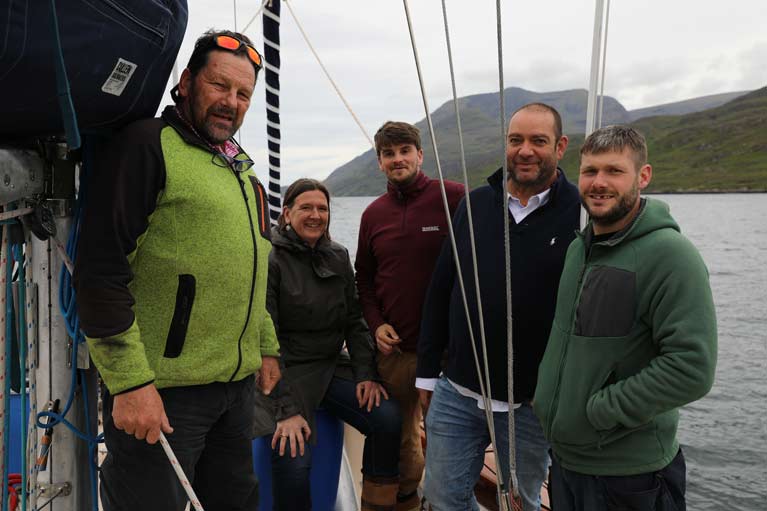 The Killary Flyer crew (minus crew Pauline Jordan and Martin Flood). In the photo from left to right are Jamie Young (Ship Captain and Director), Marieke Lexmond (Producer), Vincent Monahan (Producer, Crew & Videographer), Jeroen Hendriks (Technical Producer) and Ciaran Lennon (Skipper, Diver & Mechanic). There are two other members of the production team that are not included, those are Annette Beil (Editor) and Menno Westnedorp (Director of Photography)
The Killary Flyer crew (minus crew Pauline Jordan and Martin Flood). In the photo from left to right are Jamie Young (Ship Captain and Director), Marieke Lexmond (Producer), Vincent Monahan (Producer, Crew & Videographer), Jeroen Hendriks (Technical Producer) and Ciaran Lennon (Skipper, Diver & Mechanic). There are two other members of the production team that are not included, those are Annette Beil (Editor) and Menno Westnedorp (Director of Photography)
Young’s 15 m (50ft) aluminium yacht, Killary Flyer will sail from the Killary fjord on the Galway-Mayo border, weather permitting.
Setting a 1500 nautical mile course, the yacht will visit harbours in the West Greenland coastline, where ice “highways” are now affected by warming seas, and communities from the south up to the Arctic Circle as far as Thule is under extreme pressure.
The trip is the first of two to make a documentary about Greenland and the wider Arctic circle, Young says.
He and his crew including Ciaran Lennon, Pauline Jordan, Martin Flood, and film-maker/sailor Vincent Monahan of Duck Upon Rock Productions are working with Dutch co-producer Marieke Lexmond and her team.
The Dutch contingent includes technical producer Jeroen Hendriks, editor Annette Beil, and director of photography Menno Westendorp, who will fly to Greenland to join the yacht.
The Killary Flyer will be self-sufficient, loaded with kayaks, climbing and diving gear.
Young, from Cullbackey, Co Antrim, undertook a trip to Greenland with a crew including his son, Shane, in 2013, and has established contacts there already.
The project hopes to work with Greenland sea kayaker and guide Adam Hansen and Dubliner David Penney, who teaches in North Greenland senior high school in Aasiaat.
Lexmond, who will be “man on land” this year but will join the crew next year.
“As a country, Greenland is truly fascinating,” Monahan says.
“ Famous for its strong Inuit hunters, an incredibly resilient people have built a society where most could not,” he says.
“Having voted to move towards independence from Denmark, and their budget being 65% subsidised by the Danes they must find a way to support themselves,” he says.
“Greenland is now a new Klondyke,” Young adds, as it an estimated 50% of the world's uranium, along with other minerals which China has expressed interest in.
“The debate over the impact of all this is very similar to debates we have had in the west of Ireland on environment versus employment,” Young says.
Ilen Voyage
A separate voyage to Greenland is planned later this summer by the Limerick-built refurbished ketch Ilen, which is almost a century old and is being used for maritime education.
The Royal Irish Yacht Club in Dun Laoghaire, Co Dublin recently welcomed the Ilen, which was designed by Conor O’Brien, the first Irishman to circumnavigate the world in a small craft.
The Ilen was used for many years in the Falkland Islands as a trading craft, and was shipped back to Ireland over 20 years ago by Limerick artist and sailor Gary McMahon.
McMahon led the effort to rebuild the wooden ketch as part of a cross-community project in O’Brien’s native Limerick, and with master shipwright Liam Hegarty of Oldcourt boatyard close to Baltimore, Co Cork.
Jamie Young’s Greenland voyage can be followed here
H.W. ‘Bill’ Tilman’s mountain travel philosophy, rooted in Africa and the Himalaya and further developed in his early sailing adventures in the southern hemisphere, was honed to perfection with his discovery of Greenland as the perfect sailing destination. His Arctic voyages in the pilot cutter Mischief proved no less challenging than his earlier southern voyages. The shorter elapsed time made it rather easier to find a crew but the absence of warm tropical passages meant that similar levels of hardship were simply compressed into a shorter timescale.
First published fifty years before political correctness became an accepted rule, Mischief in Greenland is a treasure trove of Tilman’s observational wit. In this account of his first two West Greenland voyages, he pulls no punches with regard to the occasional failings, leaving the reader to seek out and discover the numerous achievements of these voyages.
This extract is taken from Chapter X11: To Godthaab and Evighedsfjord, which sees Mischief sailing through pack-ice en route to Cape Farewell.
Cape Farewell, so named by John Davis, is the southern extremity of an island 2700 feet high. Surrounded as it is by high mountains it does not stand out prominently, but like most capes that mark the culminating point of large masses of land it is noted for stormy weather. In addition much ice accumulates round it, sometimes extending as far as 150 miles seaward. But the average distance is seventy miles in April, decreasing in August to thirty miles. For our part we could not have rounded it in fairer conditions. Sailing west-northwest parallel to the coast, mountains glistening all along our starboard hand, we romped along at five knots over a sparkling blue sea on a day of brilliant sunshine. And what fascination there is in the sight of this Greenland coast; how bracing the austere beauty of sea, snow mountains, and ice! In the morning we sighted only one big solitary berg and in the afternoon passed another close enough for us to take photographs. In order to have the best light we passed it on the wrong side, that is to leeward, where we had to dodge a number of bergy bits or growlers which had broken off. A German stern-trawler from Kiel altered course to have a closer look at us and greeted us with three blasts of his siren. The air temperature that day was 36° F. and the sea 42° F.

Kangamiut (left) and Evinghedsfjord
Next day we lay becalmed. It was an equally brilliant day and the few icebergs scattered about were curiously distorted by mirage. On this account, too, we could not make out whether a white bank all along the horizon to starboard was fog or ice. At the same time we were much puzzled by a low, rumbling noise. Some thought there must be a fishing boat about, others an aeroplane. True we had a bottle-nosed whale close aboard at the time but we could not hold him responsible for a noise like that. When a breeze sprang up we closed with this white bank and found it to be heavily congested pack-ice so distorted by mirage as to appear twice its height. It was this pack-ice that in spite of the perfectly smooth sea maintained the low menacing growl which we had heard from miles away. In similar circumstances John Davis and his company had been confounded by the noise of the pack: ‘Here we heard a mighty great roaring of the sea, as if it had been the breach of some shoare, the ayr being so foggie that we could not see one ship from the other. Then coming near to the breach, we met many islands of yce floating, and did perceive that all the roaring that we heard was caused only by the rowling of this yce together.’ We sailed to within a hundred yards of the pack to take photographs before standing out to sea. From so low a viewpoint as our deck photographs of pack-ice proved singularly unimpressive. In the vicinity of the pack the sea temperature was down to 34° F.
All next day as we drifted and sailed up the coast we had the pack in sight, for apparently it filled the whole of the Julianehaab Bight as far north as Cape Desolation. Ghosting along all night we tacked once to avoid a raft of small floes covering a mile of sea. The morning broke clear and sunny and again we found ourselves surrounded by floes with just enough steerage way to avoid them. A seal lay basking on a floe but when we tried to edge close the whisper of wind failed altogether and when we started the engine he dived into the sea. In the afternoon we ran into fog. The air temperature fell to 36° F. and the moisture on the ropes froze. By evening, the fog still persisting, we found our way barred by a narrow belt of pack-ice. Although the water beyond appeared to be clear of ice we hesitated to break through and coasted westwards alongside the ice searching for an opening. For four hours we motored at four knots, dodging loose floes, and still having the more solid ice about fifty yards away on our starboard hand. At length at ten o’clock, tired of dodging stray floes and thinking I saw an opening, I turned her head towards the ice. We were nearly through when in making a tight turn to avoid a floe on the port side we suffered a frightening blow below the water-line from a tongue of ice projecting from a floe on the starboard side. Those who were below were more than a little startled. As one man they rushed on deck to see what had hit us such a sickening thud. Assuming a calm which I was far from feeling I told them we had just grazed a bit of ice, that the ship appeared not to be sinking, and that at least we were through the ice and able to resume our proper course.
The book can be purchased directly from Afloat's Marine Market at €15.67 here
Irish Cruising Comes Centre Stage In Howth Yacht Club
With last night’s Irish Cruising Club Annual General Meeting & Prize-Giving hosted at Howth Yacht Club, and this morning’s day-long ISA Cruising Conference at the same venue, centre stage has been taken by the silent majority – the large but distinctly reticent segment of the sailing population which emphatically does not have racing as its primary interest afloat. W M Nixon takes us on a guided tour.
The great Leif Eriksson would approve of some of the more adventurous members of the Irish Cruising Club. They seem to be obsessed with sailing to Greenland and cruising along its coast. And it was the doughty Viking’s father Erik Thorvaldsson (aka Erik the Red) who first told his fellow Icelanders that he’d given the name of Greenland to the enormous island he’d discovered far to the west of Iceland. He did so because he claimed much of it was so lush and fertile, with huge potential for rural and coastal development, that no other name would do.
Leif then followed in the family tradition of going completely over the top in naming newly-discovered real estate. He went even further west and discovered a foggy cold part of the American mainland which he promptly named Vinland, as he claimed the area was just one potential classic wine chateau after another, and hadn’t he brought back the vines to prove it?
In time, Erik’s enthusiasm for Greenland was seen as an early property scam. For no sooner had the Icelanders established a little settlement there around 1000 AD than a period of Arctic cooling began to set in, and by the mid-1300s there’d been a serious deterioration of the climate. What had been a Scandinavian population of maybe five thousands at its peak faded away, and gradually the Inuit people – originally from the American mainland – moved south from their first beachheads established to the northwest around 1200 AD. They proved more successful at adapting to what had become a Little Ice Age, while no Vikings were left.
Now we’re in the era of global warming, and there’s no doubt that Greenland is more accessible. But for those of us who think that cruising should be a matter of making yourself as comfortable as possible while your boats sails briskly across the sea in a temperate climate or perhaps even warmer for preference, the notion of devoting a summer to sailing to Greenland and taking on the challenge of its rugged iron coast, with ice everywhere, still takes a bit of getting used to.
Yet in recent years the Irish boats seem to have been tripping over each other up there. And for some true aficionados, the lure of the icy regions was in place long before the effects of global warming were visibly making it more accessible.
Peter Killen of Malahide, Commodore of the Irish Cruising Club, is a flag officer who leads by example. It was all of twenty years ago that he was first in Greenland with his Sigma 36 Black Pepper, and truly there was a lot of ice about. The weather was also dreadful, while Ireland was enjoying the best summer in years.

Peter Killen’s Sigma 36 Black Pepper in local ice at the quay inside Cape Farewell in Greenland, August 1995

ICC Commodore Peter Killen’s current boat is Pure Magic, an Amel Super Maramu seen here providing the backdrop for a fine penguin in Antarctica, December 2004.
More recently, he and his crew of longterm shipmates have been covering thousands of sea miles in the Amel Super Maramu 54 Pure Magic, among other ventures having a look at lots more ice down Antarctic way to see how it compares with the Arctic. With all their wanderings, by the end of the 2014 season Pure Magic was laid up for the winter in eastern Canada in Nova Scotia. So of course in order to get back to Ireland through 2015, the only way was with a long diversion up the west coast of Greenland. And the weather was grand, while Ireland definitely wasn’t enjoying the best summer in years.
The Pure Magic team certainly believe in enjoying their cruising, however rugged the terrain. If the Greenland Tourist Board are looking for a marketing manager, they could do no better than sign up the skipper of Pure Magic for the job. His entertaining log about cruising the region – featured in the usual impressive ICC Annual edited for the fourth time by Ed Wheeler – makes West Greenland seem a fun place with heaps of hospitality and friendly folk from one end to the other.

If ice is your thing, then this is the place to be – Peter Killen’s Pure Magic off the west Greenland coast, summer 2015.
But then Peter Killen is not as other men. I don’t mean he is some sort of alien being from the planet Zog. Or at least he isn’t so far as I know. But the fact is, he just doesn’t seem to feel the cold. I sailed with him on a raw Autumn day some years ago, and while the rest of us were piling on the layers, our skipper was as happy as Larry in a short-sleeved shirt.
I’d been thinking my memory had exaggerated this immunity to cold. But there sure enough in the latest ICC Annual is a photo of the crew of Pure Magic enjoying a visit to the little Katersugaasivik Museum in Nuuk, and the bould skipper is in what could well be the same skimpy outfit he was wearing when we sailed together all those years ago. As for the rest of the group, only tough nut Hugh Barry isn’t wearing a jacket of some sort – even Aqqala the Museum curator is wearing one.
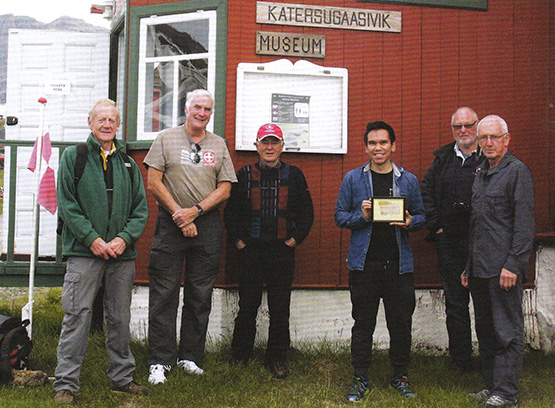
Some folk feel the cold more than others – Pure Magic’s crew absorbing local culture in Greenland are (left to right) Mike Alexander, Peter Killen, Hugh Barry, Aqqalu the museum curator, Robert Barker, and Joe Phelan
Having a skipper with this immunity to cold proved to be a Godsend before they left Greenland waters, when Pure Magic picked up a fishing net in her prop while motoring in a calm. Peter Killen has carried a wetsuit for emergencies for years, and finally it was used. He hauled it on, plunged in with breathing gear in action, and had the foul-up cleared in twenty minutes. Other skipper and Commodores please note……
The adjudicator for the 2015 logs was Hilary Keatinge, who has one of those choice-of-gender names which might confuse, so it’s good news to reveal that after 85 years, the ICC has had its first woman adjudicator. No better one for the job, man or woman. Before marrying the late Bill Keatinge, she was Hilary Roche, daughter of Terry Roche of Dun Laoghaire who cruised the entire coastline of Europe in a twenty year odyssey of successive summers, and his daughter has proven herself a formidable cruising person, a noted narrator of cruising experiences, and a successful writer of cruising guides and histories.
Nevertheless even she admitted last night that once all the material has arrived on the adjudicator’s screen, she finally appreciated the enormity of the task at hand, for the Irish Cruising Club just seems to go from strength to strength. Yet although it’s a club which limits itself to 550 members as anything beyond that would result in administrative overload and the lowering of standards, it ensures that the experience of its members benefit the entire sailing community through its regularly up-dated sailing directions for the entire coast of Ireland. And there’s overlap with the wider membership of the Cruising Association of Ireland, which will add extra talent to the expert lineup providing a host of information and guidance at today’s ISA Cruising Conference.
But that’s this morning’s work. Meanwhile last night’s dispensation of the silverware – some of which dates back to 1931 – revealed an extraordinarily active membership. And while they did have those hardy souls who ventured into icy regions, there were many others who went to places where the only ice within thousands of miles was in the nearest fridge, and instead of bare rocky mountains they cruised lush green coasts.
Nevertheless the ice men have it in terms of some of the top awards, as Hilary Keatinge has given the Atlantic Trophy for the best cruise with a passage of more than a thousand miles to the 4194 mile cruise of Peter Killen’s Pure Magic from Halifax to Nova Scotia to Howth, with those many diversions on the way, while the Strangford Cup for an alternative best cruise goes to Paddy Barry, who set forth from Poolbeg in the heart of Dublin Port, and by the time he’d returned he’d completed his “North Atlantic Crescent”, first to the Faeroes, then Iceland to port, then across the Denmark Strait to southeast Greenland for detailed cruising and mountaineering, then eventually towards Ireland but leaving Iceland to port, so they circumnavigated it in the midst of greater enterprises.
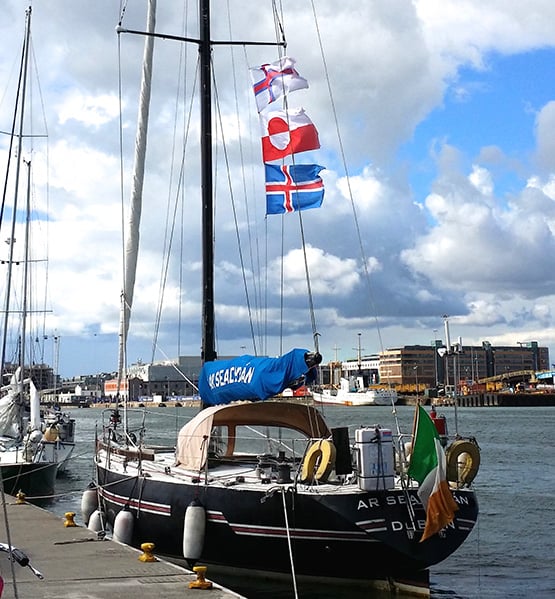
You collect very few courtesy ensigns in the frozen north. Back at Poolbeg in Dublin after her “North Atlantic Crescent” round Iceland and on to Greenland, Paddy Barry’s Ar Seachran sports the flags of the Faroes, Iceland and Greenland. Ar Seachran is a 1979 alloy-built Frers 45. Photo: Tony Brown
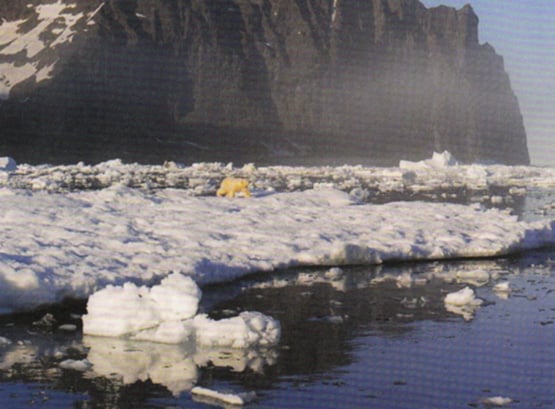
“Definitely the Arctic”. A polar bear spotted from Ar Seachran. Photo: Ronan O Caoimh
Paddy Barry started his epic ocean voyaging many years ago with the Galway Hooker St Patrick, but his cruising boat these days is very different, a classic Frers 45 offshore racer of 1979 vintage. Probably the last thing the Frers team were thinking when they turned out a whole range of these gorgeous performance boats thirty-five years ago was that their aluminium hulls would prove ideal for getting quickly to icy regions, and then coping with sea ice of all shapes and ices once they got there. But not only does Paddy Barry’s Ar Seacrhran do it with aplomb, so too does Jamie Young’s slightly larger sister, the Frers 49 Killary Flyer (ex Hesperia ex Noryema XI) from Connacht, whose later adventures in West Greenland featured recently in a TG4 documentary.
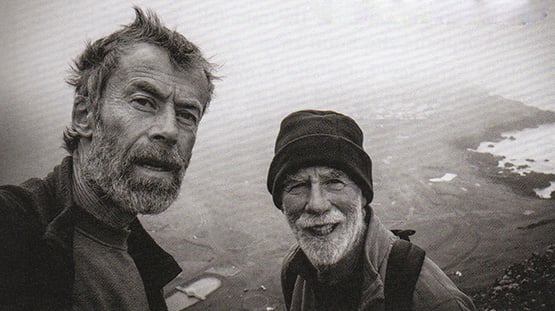
“A grand soft day in Iceland”. Harry Connolly and Paddy Barry setting out to take on mountains in Iceland during their award-winning cruise to Greenland. Photo: Harry Connolly
Pure Magic and Ar Seachran are hefty big boats, but the other ICC voyager rewarded last night by Hilary Keatinge for getting to Arctic waters did his cruise in the Lady Kate, a boat so ordinary you’d scarcely notice her were it not for the fact that she’s kept in exceptionally good trim.
Drive along in summer past the inner harbour at Dungarvan in West Waterford at low water, and you’ll inevitably be distracted by the number of locally-based bilge-keelers sitting serenely upright (more or less) on that famous Dungarvan mud. There amongst them might be the Moody 31 Lady Kate, for Dungarvan is her home port.
But she was away for quite a while last year, as Donal Walsh took her on an extraordinary cruise to the Arctic, going west of the British mainland then on via Orkney and Shetland to Norway whose coast goes on for ever until you reach the Artic Circle where the doughty Donal had a swim, as one does, and looked at a glacier or too, and then sailed home but this this time leaving the British mainland to starboard. A fabulous 3,500 mile eleven week cruise, he very deservedly was awarded the Fingal Cup for a venture the adjudicator reckons to be extra special – as she puts it, “you feel you’re part of the crew, though I don’t think I’d have done the Arctic Circle swim.”
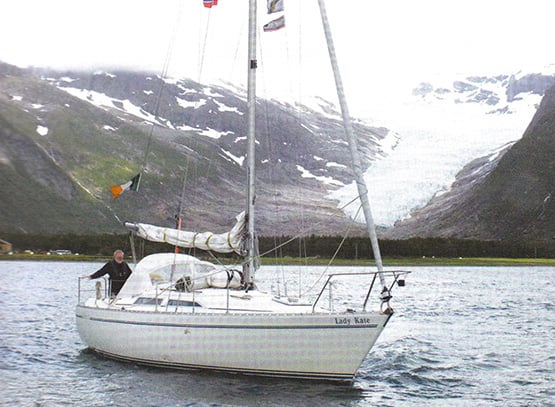
A long way from Dungarvan. Lady Kate with Donal Walsh off the Svartsen Glacier in northern Norway
Indeed, in taking an overview of the placings of the awards, you can reasonable conclude that the adjudicator reckons any civilized person can have enough of ice cruising, as she gives the ICC’s premier trophy, the Faulkner Cup, to a classic Atlantic triangle cruise to the Azores made from Dun Laoghaire by Alan Rountree with his van de Sadt-designed Legend 34 Tallulah, a boat of 1987 vintage which he completed himself (to a very high standard) from a hull made in Dublin by BJ Marine.
Tallulah looks as immaculate as ever, as we all saw at the Cruising Association of Ireland rally in Dublin’s River Liffey in September. And this is something of a special year for Alan Rountree, as completely independently of the Faulkner Cup award, the East Coast ICC members awarded their own area trophy, the Donegan Cup for longterm achievement, to Tallulah’s skipper. As one of those involved in the decision put it, basically he got the Donegan Trophy “for being Alan Rountree – what more can be said?”
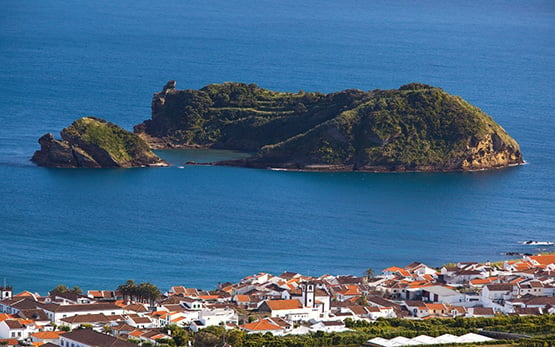
The essence of the Azores. Red roofs maybe, but not an iceberg in sight, and the green is even greener than Ireland. Alan Rountree’s succesful return cruise to the Azores has been awarded the ICC’s premier trophy, the Faulkner Cup.

Tallulah at the CAI Rally in the Liffey last Setpember. She looks as good today as when Alan Rountree completed her from a bare hull nearly thirty years ago. Photo: W M Nixon
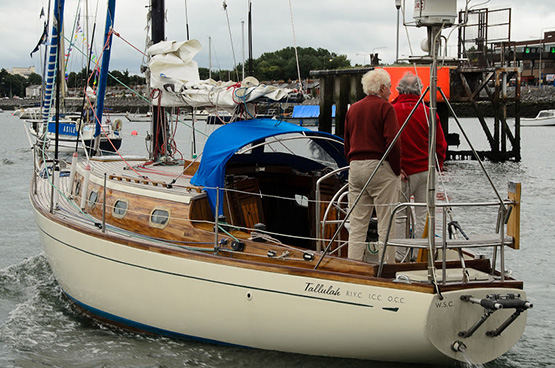
A boat to get you there – and back again. Tallulah takes her departure from the CAI Rally in Dublin. Photo: Aidan Coughlan
Well, it can be said that his Azores cruise was quietly courageous, for although the weather was fine in the islands, the nearer he got to Ireland the more unsettled it became, and he sailed with the recollection of Tallulah being rolled through 360 degrees as she crossed the Continental Shelf in a storm in 1991. But he simply plodded on through calm and storm, the job was done, and Tallulah is the latest recipient of a trophy which embodies the history of modern Irish cruising.
There were many other awards distributed last night, and for those who think that the ICC is all about enormous expensively-equipped boats, let it be recorded that the Marie Trophy for a best cruise in a boat under 30ft long went to Conor O’Byrne of Galway who sailed to the Hebrides with his Sadler 26 Calico Jack, while the Fortnight Cup was taken by a 32-footer, Harry Whelehan’s Jeanneau Sun Odyssey 32 for a fascinating cruise in detail round the Irish Sea, an area in which, the further east you get to coastlines known to very few Irish cruising men, then the bigger the tides become with very demanding challenges in the pilotage stales.
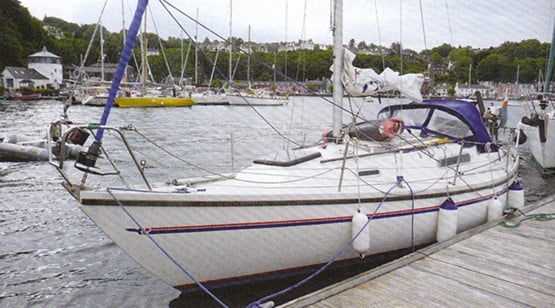
The smallest boat to be awarded a trophy at last night's Irish Cruising Club prize-giving was Conor O’Byrne’s Sadler 26 Calico Jack, seen here in Tobermory during her cruise from Connacht to the Hebrides
As for “expensively equipped”, the Rockabill Trophy for seamanship went to Paul Cooper, former Commodore of Clontarf Yacht & Boat Club and an ICC member for 32 years, who solved a series of very threatening problems with guts and ingenuity aboard someone else’s Spray replica during a 1500 mile voyage in the Caribbean, with very major problems being skillfully solved, as the judge observed, “without a cross word being spoken”.
Not surprisingly in view of the weather Ireland experienced for much of the season, there were no contenders for the Round Ireland cruise trophy, though I suppose you could argue that the return of Pure Magic meant the completion of a round Ireland venture, even if in this case the Emerald Isle becomes no more than a mark of the course.
In fact, with the unsettled weather conditions of recent summers in Ireland , there’s now quite a substantial group of ICC boats based out in Galicia in northwest Spain, where the mood of the coast and the weather “is like Ireland only better”. The ICC Annual gives us a glimpse of the activities of these exiles, and one of the most interesting photos in it is provided by Peter Haden of Ballyvaughan in County Clare, whose 36ft Westerly Seahawk Papageno has been based among the Galician rias for many years now.
Down there, the Irish cruising colony can even do a spot of racing provided it’s against interesting local tradtional boats, and Peter’s photo is of Dermod Lovett of Cork going flat out in his classic Salar 40 Lonehort against one of the local Dorna Xeiteras, which we’re told is the Galician equivalent of a Galway Bay gleoiteog. Whatever, neither boat in the photo is giving an inch.
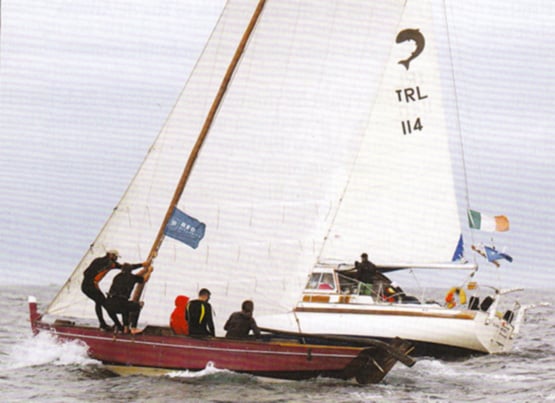
So who never races? Dermod Lovett ICC in competition with his Salar 40 Lonehort against a local traditional Dorna Xeiteira among the rias of northwest Spain. Photo: Peter Haden
Hilary Keatinge’s adjudication is a delight to read in itself, and last night after just about every sailing centre in Ireland was honoured with an ICC award for one of its locally-based members, naturally the crews leapt to the mainbrace and great was the splicing thereof.
But it’s back to porridge this morning in HYC and the serious work of the ISA Cruising Conference, where the range of topics is clearly of great interest, for the Conference was booked out within a very short time of being highlighted on the Afloat.ie website.
It’s during it that we’ll hear more about that intriguing little anchorage which provides our header photo, for although it could well be somewhere on the Algarve in Portugal, or even in the Ionian islands in Greece were it not for the evidence of tide, it is in fact on the Copper Coast of south Waterford, between Dungarvan and Dunmore East, and it’s known as Blind Harbour.
It’s a charming place if you’ve very settled weather, but it’s so small that you’d probably need to moor bow and stern if you were thinking to overnight, but that’s not really recommended anyway. Norman Kean, Editor of the Irish Cruising Club Sailing Directions, had heard about this intriguing little spot from Donal Walsh of Dungarvan (he who has just been awarded the Fingal Cup), and being Norman Kean, he and Geraldine just had to go and experience it for themselves. But it has taken three attempts to have the right conditions as they were sailing by, and it happened in 2015 in a very brief period of settled weather as they headed past in their recently-acquired Warrior 40 Coire Uisge, which has become the new flagship of the ICC’s informal survey flotilla.

The secret cove is to be found on Waterford’s Copper Coast, midway between Dungarvan and Dunmore East. Courtesy ICC
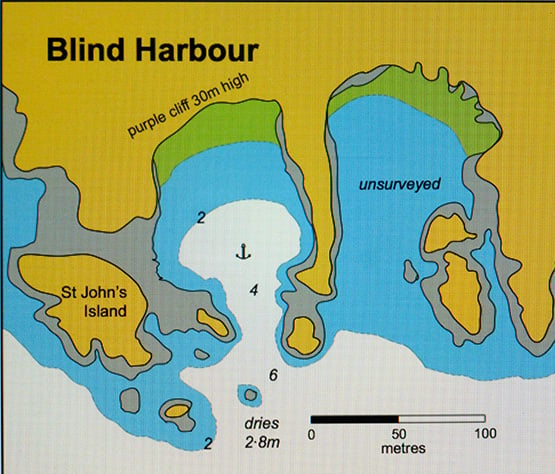
The newly-surveyed Blind Harbour on the Waterford coast as it appears in the latest edition of the ICC’s South & West Coasts Sailing Directions published this month. Courtesy ICC.
They found they’d to eye-ball their way in to this particular Blind Harbour (there are others so-named around the Irish coast) using the echo sounder, as any reliance on electronic chart assistance would have had them on the nearest part of County Waterford, albeit by only a matter of feet. With a similar exercise a couple of years ago, they found that the same thing was the case at the Joyce Sound Pass inside Slyne head in Connemara – rely in the chart plotter, and you’re making the pilotage into “impactive navigation”.
The message is that some parts of charts are still relying on surveys from a very long time ago, and locations of hyper-narrow channels may be a few metres away from where they actually are. On the other hand, electronic anomalies may arise. Whatever the reason, I know that a couple of years ago, in testing the ship’s gallant little chart plotter we headed for the tricky-enough Gillet passage inside the South Briggs at the south side of the entrance to Belfast Lough, and found that it indicated the rocks as shown were a tiny bit further north than we were seeing, which could have caused a but of a bump if we’d continued on our electronic way.
Electronic charts are only one of many topics which will be covered today. We hope to bring a full report next Saturday, for the participants will in turn require a day or two to digest their findings.
New Photo Exhibition Charts Arctic Circle Adventure
#Arctic - The visual fruits of last summer's epic North Of Disko expedition from Galway Bay to Greenland and the Arctic will be on show at a new exhibition in Dublin.
TheJournal.ie has a sample of some of Daragh Muldowney's photographs from the voyage that comprise the new gallery show at The Copper House, off Synge Street in Portobello, from this Wednesday 1 October till Friday 7 November.
Muldowney's stunning shots take in all the majestic sights he and his fellow adventurers were treated to on their 1,600-mile voyage across the North Atlantic to Aasiaat in western Greenland, travelling north along the Baffin Bay coast to Upernavik, inside the Arctic Circle.
As previously reported on Afloat.ie, from there a team of four set out on an unsupported sea kayak expedition to explore the region's fjords and ice fields, followed on land by a team of climbers tackling some of the area's frozen peaks.
Also launching at Muldownney's exhibition this week is his book of photographs from the voyage, Out of Thin Air.
TheJournal.ie has more on the story HERE.
Irish Cruising – Sailing's Magic Elixir for a Long Life
#cruising – Cruising is the hidden side of sailing, yet it's the choice for the majority of those going afloat. Whether it's day cruising, a longer venture in the annual holidays, or the dream cruise of a lifetime across oceans, this is our sport. Unlike racing, which generates its own narrative even if only through the recorded results, much of cruising would slip under the radar completely were it not for cruising awards. W M Nixon considers the latest annual batch from the Irish Cruising Club.
Cruising under sail seems to be the secret of eternal youth. Last night's Annual General Meeting of the Irish Cruising Club in Dun Laoghaire saw a distribution of awards to voyagers from all parts of Ireland who sailed successfully in many areas of the globe in boats mostly of modest size. Yet any outside analyst would soon have made the point that many of the achievers were of mature – sometimes very mature - years, and fulfilling a retirement dream.
But despite any ICC membership gathering these days being a sea of silver heads, age is the last thing they think about. This club of 550 members has become the mixture of an Active Retirement Association – very active indeed, as it happens – and a sort of seagoing extension of the Men's Shed movement.
If you were looking for an illustration of Ireland's changing demographics, and our very rapidly changing attitude as to what constitutes old age, you need look no further than the ICC. Time was when it was thought quite something when one of the club achieved the Golden Jubilee of their membership. But these days, it's no big deal to have been on the strength for fifty years, as the senior member is Joe FitzGerald of Crosshaven, who this year marks 70 years in the club, and he is closely followed by Douglas Mellon who joined in 1947 from Howth - he now lives on the Scottish Riviera in Kircudbright.
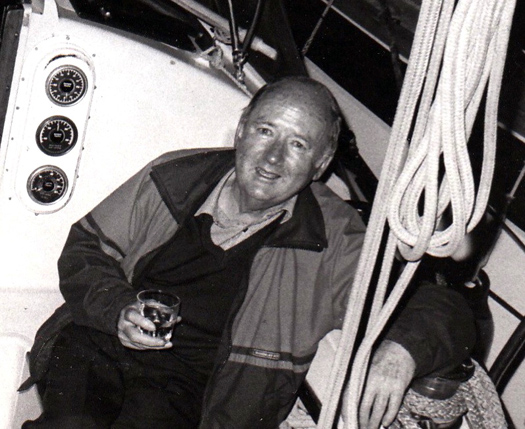
Joe FitzGerald of Cork is the ICC's most senior member, having joined in 1944. He served as Commodore from 1984 to 1987.
All those years ago when they took up their membership, it was thought perfectly normal for young men – married or otherwise - to take off for at least a fortnight's cruising every year, regardless of family demands which these days would be regarded as the prior commitment. In fact, nowadays so much emphasis is placed on family life and families doing just about every last recreational thing together, that younger married sailing people either do extremely short-hop cruising of the type necessitated by catering for the needs of all the members of the family, or else they don't cruise at all in the traditional sense - "Fun For All The Family" effectively rules out proper cruising.
Then too, modern life has so many other distractions - not least of them work demands which involve 24/7 attention - that the old-style easygoing simply-wandering-along holiday cruising is very much a minority activity. This means that at first it seems young people are not taking up traditional cruising at all. But with its deep experience garnered since its foundation in 1929, the Irish Cruising Club has learned to take the long view. It is not unduly concerned by the steadily rising age profile of its membership, and certainly every year there is a significant group of sometimes quite senior yet nevertheless increasingly active cruising enthusiasts joining the club.
They're the embodiment of the slogan that Sailing is a Sport for Life, and it's only politeness which prevents them saying that the subtle pleasures of cruising are wasted on the young. So when you look at the lineup of achievement represented by last night's awards, it's natural to wonder what these people did in earlier life, that they can nowadays afford the time, resources and dedication necessary to complete voyages of this quality.
The adjudication was done by Dave Whitehead of Kinvara on Galway Bay, himself no stranger to the ways of the sea while making long voyages in small craft. He breaks new ground by awarding three trophies at once to Sam Davis of Strangford Lough, whose Cape Horn and Pacific ventures with his Rival 41 Suvretta have been quietly bubbling away in the background of ICC activity for the past three years.
Sam Davis first featured in Afloat magazine in March and April 1981 when we ran his two-part account of his first ocean voyage, an Atlantic circuit from Strangford Lough between 1976 and 1979 with the 34.5ft West Solent Class Suvretta, a former racing boat he'd found in a derelict state and restored to ocean-going condition.

The 34ft West Solent class Suvretta in her offshore racing days in the 1950s when she was based in Belfast Lough. When Sam Davis did the Atlantic Circuit cruise with her in 1976-79, she carried a less loft mainmast, with masthead rig.
But even with Sam's improvements, she was still no more than a slip of a boat, so it says much for his grit and skill that he brought her through the Fastnet storm of 1979 as he sailed the final hundred miles back to Ireland. There was damage aloft, and he'd to get into Dunmore East unaided with jury rigging, but the job was done.
While in the Caribbean, he'd worked in charter yachts between times to make a shilling or two. But after he'd spent time back in Northern Ireland, he went abroad into serious seafaring in offshore service industries, working in places like The Gulf, the North Sea, the Amazon, the Red Sea and Malaysia, becoming a fully accredited Marine Consultant.
Yet if you ask him nowadays what he is and what he was, he'll say he's a farmer and former seaman, as his purchase some years ago of Conly Island in Strangford Lough (you can drive out to it when the tide is down) gives him the little bit of land, and an anchorage too, while "seaman" covers his many experiences in offshore work.
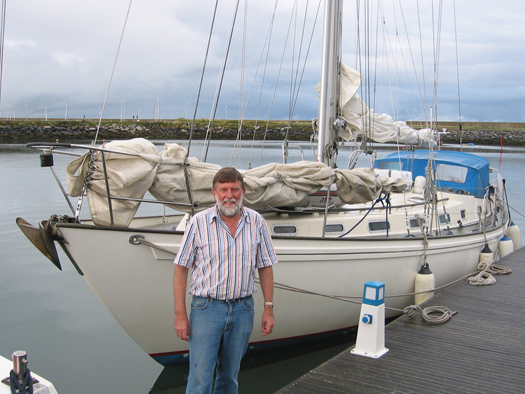
Sam Davis with his newly-acquired Rival 41, re-named Suvretta, in 2009. Photo: W M Nixon

Suvretta in the Beagle Channel in southern Chile. Photo: Sam Davis
Back in 2009 he bought a Rival 41, a hefty and able vessel, a sister-ship of Waxwing in which fellow ICC members Peter and Susan Gray of Dun Laoghaire went round the world 14 years ago. Sam re-named his new boat Suvretta, spent the winter sorting her out, and in 2010 he was gone, sailing south single-handed to eventually round Cape Horn and then spend a long time on the coast of Chile. He was delayed there as a ship broke drift and damaged the boat, but it was well fixed, and he voyaged on into the Pacific to many islands, including Pitcairn and the Tahiti group.
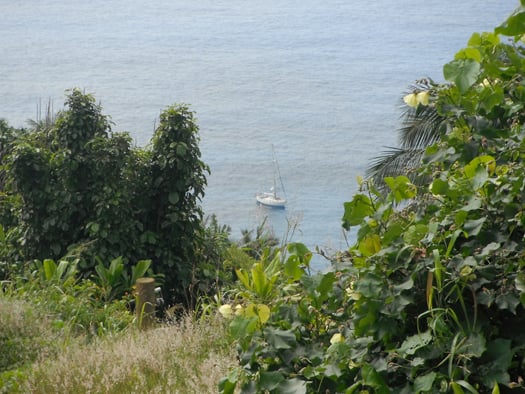
Restless anchorage. Suvretta in Bounty Bay on Pitcairn Island. Photo: Sam Davis
Eventually he fetched up for some time in Tonga, where he became enthused about the 73ft Vakas, the Pacific islanders' contemporary take on the classic Polynesian inter-island vessels (see Sailing on Saturday 11th January 2014). But by November 2012 it was time to head for home, so Suvretta sailed southeast for Cape Horn non-stop, and having rounded it, shaped her course for Port Stanley in the Falklands.
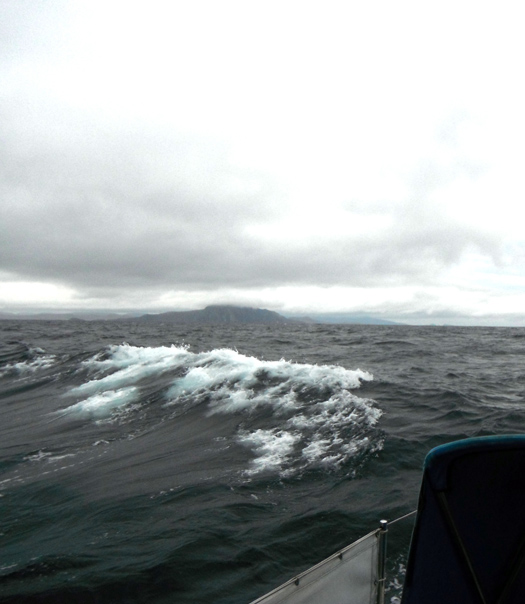
Suvretta rounding Cape Horn for the second time, 21st January 2013. It was only when the Horn was well astern that the weather deteriorated rapidly to make for a challenging approach to Port Stanley. Photo: Sam Davis
However, while rounding the Horn had been simple enough, the passage onwards to Stanley became increasingly fraught, running before rising storm force winds. Conditions were such that it looked for a while as though the lone sailor was going to be swept right past the islands, but he made the cut into shelter to such a nicety that he is awarded the ICC's Rockabill Trophy for Seamanship.
And then when Port Stanley was reached, a very fine passage had been completed from Tonga, so last night for that he was additionally awarded the ICC's Atlantic Trophy for the best voyage with a non-stop leg of more than a thousand miles. And then finally, after they'd spent the mid part of 2013 working their way up the Atlantic with the lone skipper particularly enjoying himself at ports on the Irish coast, Suvretta and Sam returned after three years to Conly Island. And they'd now done more than enough to also be awarded a third trophy - the ICC's premier honour, the Faulkner Cup.
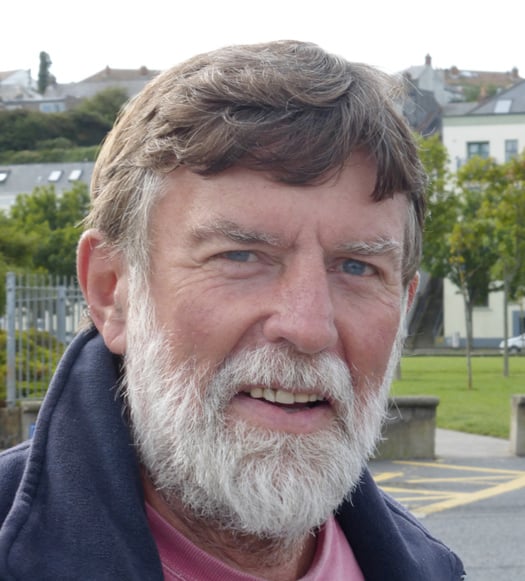
Home again. Sam Davis back in Ireland, August 2013. Photo: W M Nixon
With such a high level of activity by many members, ICC adjudicators always find some final choices to be a very close call, so some years ago the Strangford Cup was inaugurated for the cruise which almost won the Faulkner Cup. This year it has gone to a fine cruise from Portugal to Madeira and through the Azores in detail before returning to Portugal.
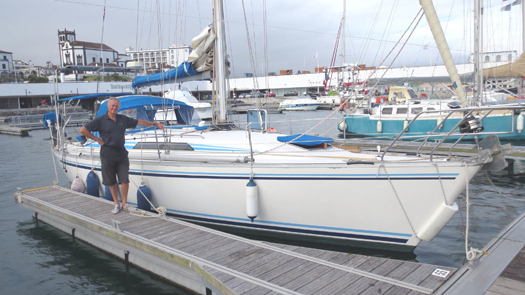
John Duggan with his MG CS40 Hecuba in Horta in the Azores
John Duggan originally hailed from Malahide where he sailed, and he also sailed with the college teams while at Trinity College in Dublin. He cruised and raced offshore mostly in the Irish Sea, but having qualified as an accountant he decided to spread his wings internationally, and he became one of those key people who turn up as partners in one of the big four accountancy firms worldwide.
Eventually his career brought him to the company's offices in Lisbon. Living in Portugal suited him fine, so he put down roots and in time bought himself an interesting cruiser. Hecuba is a 1989 Canadian-built Tony Castro-designed MG CS40, a handsome 12m craft with good performance enhanced by an effective wing keel.
During his final years in the day job he gradually improved the boat with a mind to some proper cruising once he retired at 60, something which he planned with all a high-powered accountant's meticulous attention to detail. He remembers the final day at the office, when a friend on the other side of the world sent him an email: "Even the worst day of your retirement will be better than the best day at work".

Azorean whaleboat with Pico beyond seen during one of Hecuba's cruises from Portugal to the Azores. Photo: John Duggan
Maybe so, yet not everyone makes the changeover smoothly, but in John Duggan's case the challenge of planning and executing remarkably civilised yet challenging cruises has proven to be a complete new job in itself, but much more fun than number crunching. He goes to enormous trouble to make sure that his crews have as enjoyable and varied an experience as possible, yet all the time he is quietly keeping the project moving along while noting details and features of ports visited which might be of interest to fellow skippers, a habit which is the hallmark of the true cruising man.
When you live in Cascais with your boat based in the marina nearby, the Azores are the western isles which call you each summer. But unlike Scotland's Western Isles which are just a day's sail away across the Sea of the Hebrides, the Azores involve an immediate ocean voyage from Portugal of at least 500 miles. However, for 2013's cruise west, Hecuba made it a triangle, going first to Madeira before going on nor'west to the Azores which were cruised in detail before returning to Cascais after six weeks away, having logged 2390 miles, with the final tabulation being:
Hours spent close hauled: Zero.
Cross words exchanged: Zero.
Inevitably the two big awards dominate the scoresheet, but the ICC also has a host of trophies which reflect every level of club sailing activity. The Round Ireland Cup, for instance, is for the circuit which produces most information for the club's sailing directions, and in a year in which a goodly number went round, it was Donal Walsh of Dungarvan with his Moody 31 Lady Kate who best filled the bill.

Donal Walsh's Lady Kate anchored at Inishmurray off the Sligo coast during his detailed round Ireland cruise. Photo: Donal Walsh
As the Faulkner Cup was first won in 1931 by the 28ft cutter Marie, the Marie Trophy is for the best cruise by a boat under 30ft, and Mick Delap from Valentia Island with his Tamarisk 24 gaff cutter North Star fits into the size requirement with six feet to spare. He made a fine job of completing a two-summer circuit of Ireland by returning from western Scotland via the Irish Sea and Ireland's south and southwest coasts.

Mick Delap's Tamarisk 24 North Star from Valentia in Lowlandman's Bay in Jura in the Hebrides. Photo: Mick Delap
In all, the ICC has a dozen cruising trophies. But even so not everyone gets one in a typically busy year, so to encourage the newcomers they've the Perry Greer Trophy for first time log-writers, and it goes to Peter Mullan from the Quoile in Strangford Lough for his insightful account of a round Ireland cruise with the Jeanneau Sun Odyssey Sancerre.
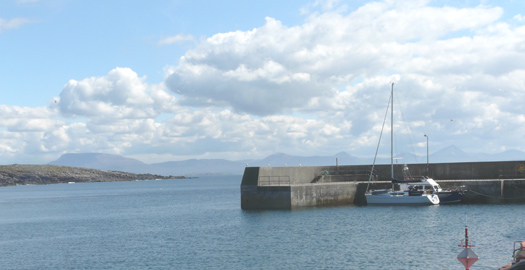
Peter Mullan's Sun Odyssey Sancerre in the little harbour at Tory Island with the Donegal highlands beyond. Photo: Peter Mullan
All the logs, including the winning ones, were featured in the ICC's 180-page Annual 2013, which Honorary Editor Ed Wheeler managed to get to the members in time for Christmas. All this is done by voluntary effort, yet the Annual would stand up to professional comparisons, as it includes informative accounts of cruises in just about every part of the world, plus a report on the ICC Cruise-in-Company to the Isles of Scilly which was an outstanding success despite coinciding with some uneven weather in June.
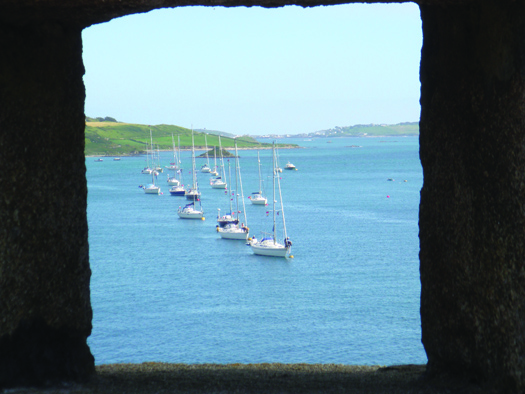
The Irish Cruising Club flotilla in the Isles of Scilly during their successful Cruise-in-Company in June 2013.

Everyone to his taste. ICC member Brian Black went to Greenland for the sixth time, crewing on Aurora. This is Kangertitiatsivaq Fjord in high summer. Photo: Brian Black
There's more to the Club than the Annual, as the ICC's programme of producing constantly up-dated Sailing Directions for the entire Irish coast in two volumes is a continuous progression, with the latest 12th Edition of the North & East Coast Book due next month from Honorary Editor Norman Kean, whose home port is Courtmacsherry.
Thus it's clear that Ireland's cruising club is a truly all-Ireland organisation, and this year it will be celebrating its 85th birthday with a Cruise-in-Company to Glengarriff where it was founded on July 13th 1929. Yet despite its obvious significance, this is a club without premises. In the final analysis, it's a club of the mind, made up of kindred spirits. Heading such a body is a mighty challenge, and the changing of the watch is always a charged moment.
Last night David Tucker of Kinsale stood down after serving his three years as Commodore, and he was succeeded by Peter Killen of Malahide. His experience in club administration is long-lived – he was Commodore of Malahide YC when it became "Club of the Year" in 1980. But it was his cruising CV which next went into overdrive, as in 1993 he voyaged north to Iceland, circled it, and then sailed back in near-record time in an S&S 30. He then moved up to a Sigma 36 which he cruised to Greenland among other places, following which he cruised even further with a Sweden 38, and then in 2004 he took on his dreamship, the Amel Maramu 54 Pure Magic.
Peter Killen seems to have cruised this very special boat just about everywhere. Not least was deep into Antarctica, where he made a memorable arrival in zero visibility with icy conditions into the natural harbour in the extinct volcanic crater on Deception Island. It was all a long way in time and distance from five boats gathered in Glengarrif in the hope of forming a little cruising organisation back in 1929. But that's the way it is with the Irish Cruising Club.
Melting Glaciers A Factor in Irish River Salmon Decline
#ANGLING - Climate change in the Atlantic may be a significant factor in the decline of wild salmon returning to their native rivers in Ireland - especially with the news that a section of ice twice the size of Manhattan has calved from a glacier in Greenland.
Angling correspondent Derek Evans writes in The Irish Times about the major ice sheet separation along the north-west coast of Greenland, which experts have attributed to warming ocean temperatures.
It is the second such indident to occur in the past three years, after the Petermann glacier lost some 97 square miles of ice in August of 2010.
As reported on Afloat.ie last year, the effects of climate change on the world's oceans are forcing species such as wild salmon to adapt by feeding in colder waters.
The Irish Times has more on the story HERE.






























